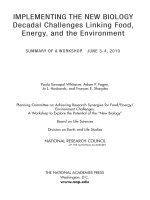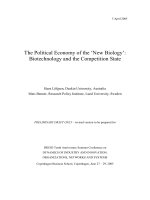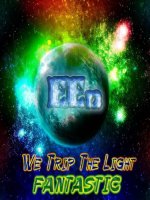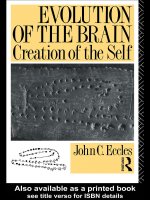Panno the cell evolution of the first organism the new biology
Bạn đang xem bản rút gọn của tài liệu. Xem và tải ngay bản đầy đủ của tài liệu tại đây (17.6 MB, 206 trang )
www.elsolucionario.net
www.elsolucionario.net
THE CELL
www.elsolucionario.net
www.elsolucionario.net
T H E
new biology
THE CELL
Evolution of the First Organism
Joseph Panno, Ph.D.
www.elsolucionario.net
THE CELL: Evolution of the First Organism
Copyright © 2005 by Joseph Panno, Ph.D.
All rights reserved. No part of this book may be reproduced or utilized in any form or
by any means, electronic or mechanical, including photocopying, recording, or by any
information storage or retrieval systems, without permission in writing from the publisher. For information contact:
Facts On File, Inc.
132 West 31st Street
New York NY 10001
Library of Congress Cataloging-in-Publication Data
Panno, Joseph.
The cell : evolution of the first organism / Joseph Panno.
p. cm. — (New biology)
Includes bibliographical references and index.
ISBN 0-8160-4946-7 (alk. paper)
1. Cells—Popular works. 2. Cells—Evolution—Popular works. I. Title.
QH582.4.P36 2004
571.6—dc222003025841
Facts On File books are available at special discounts when purchased in bulk quantities
for businesses, associations, institutions or sales promotions. Please call our Special
Sales Department in New York at (212) 967-8800 or (800) 322-8755.
You can find Facts On File on the World Wide Web at
Text design by Erika K. Arroyo
Cover design by Kelly Parr
Illustrations by Sholto Ainslie and Joseph Panno
Printed in the United States of America
MP FOF 10 9 8 7 6 5 4 3 2 1
This book is printed on acid-free paper.
www.elsolucionario.net
For my wife, Diana,
who worked with me in the lab for many years,
and for my daughter Eleanor,
who knew about cells before she could read or write.
V
www.elsolucionario.net
www.elsolucionario.net
CONTENTS
V
Preface
Acknowledgments
Introduction
1
2
3
The Origin of Life
xi
xiii
xv
1
The Big Bang
The Importance of Violent Storms
Essential Molecules Formed Spontaneously
Life Began in an RNA World
Once upon a Wave
The Classification of Cells
1
2
4
10
11
15
Prokaryotes: Laying the Foundations
17
A Simple but Versatile Cell
The Quest for Power
The Importance of Good Housekeeping
A Lost World
A New Genetic Order
The Good, the Bad, and the Ugly
17
21
26
27
28
32
Eukaryotes: Dawn of a New Era
38
Overview of Eukaryote Structure and Function
The Nucleus
Protein Synthesis
Designing a Molecular Forest
The Birth of Communication
40
45
48
49
52
www.elsolucionario.net
4
5
6
7
Symbiosis and the Quest for Power
57
Recycling and Defense
58
The Cell Cycle
60
DNA Replication
62
Binary Fission
67
Mitosis
67
Meiosis
70
Genes
75
The Human Genome Project
76
The Future of Genomic Research
83
Turning Genes On and Off
84
Gene Monitors and Repair Crews
88
Jumping Genes
90
From Cells to Bodies
92
The Road to Multicellular Creatures
92
Cell Junctions
96
Cells in the Human Body
98
Cells of the Immune System
108
Neurons: Pushing Back the Night
112
Neural Anatomy
113
Signal Transduction
114
The Synaptic Junction
118
Myelination
118
Neurotransmitters
121
Neural Circuits
122
Summary
125
www.elsolucionario.net
8
Resource Center
126
Light Microscopy
126
Histology and Histochemistry
130
Recombinant DNA Technology
133
Glossary
147
Further Reading
173
Index
177
www.elsolucionario.net
www.elsolucionario.net
PREFACE
V
The New Biology set consists of the following six volumes: The Cell,
Animal Cloning, Stem Cell Research, Gene Therapy, Cancer, and Aging.
The set is intended primarily for middle and high school students, but
it is also appropriate for first-year university students and the general
public. In writing this set, I have tried to balance the need for a comprehensive presentation of the material, covering many complex fields,
against the danger of burying—and thereby losing—young students
under a mountain of detail. Thus the use of lengthy discussions and
professional jargon has been kept to a minimum, and every attempt has
been made to ensure that this be done without sacrificing the important elements of each topic. A large number of drawings are provided
throughout the series to illustrate the subject matter.
The term new biology was coined in the 1970s with the introduction
of recombinant DNA technology (or biotechnology). At that time, biology was largely a descriptive science in danger of going adrift. Microbiologists at the turn of the century had found cures for a few diseases,
and biologists in the 1960s had cracked the genetic code, but there was
still no way to study the function of a gene or the cell as a whole.
Biotechnology changed all that, and scientists of the period referred to
it as the new technique or the new biology. However, since that time it
has become clear that the advent of biotechnology was only the first
step toward a new biology, a biology that now includes nuclear transfer
technology (animal cloning), gene therapy, and stem cell therapy. All
these technologies are covered in the six volumes of this set.
The cell is at the very heart of the new biology and thus figures
prominently in this book series. Biotechnology was specifically designed
for studying cells, and using those techniques, scientists gained insights
into cell structure and function that came with unprecedented detail.
xi
www.elsolucionario.net
xii The Cell
As knowledge of the cell grew, the second wave of technologies—
animal cloning, stem cell therapy, and gene therapy—began to appear
throughout the 1980s and 1990s. The technologies and therapies of
the new biology are now being used to treat a wide variety of medical
disorders, and someday they may be used to repair a damaged heart, a
severed spinal cord, and perhaps even reverse the aging process. These
procedures are also being used to enhance food crops and the physical
characteristics of dairy cows and to create genetically modified sheep
that produce important pharmaceuticals. The last application alone
could save millions of lives every year.
While the technologies of the new biology have produced some
wonderful results, some of the procedures are very controversial. The
ability to clone an animal or genetically engineer a plant raises a host of
ethical questions and environmental concerns. Is a cloned animal a
freak that we are creating for our entertainment, or is there a valid medical reason for producing such animals? Should we clone ourselves, or use
the technology to re-create a loved one? Is the use of human embryonic
stem cells to save a patient dying from leukemia a form of high-tech
cannibalism? These and many other questions are discussed throughout the series.
The New Biology set is laid out in a specific order, indicated previously, that reflects the natural progression of the discipline. That is,
knowledge of the cell came first, followed by animal cloning, stem cell
therapy, and gene therapy. These technologies were then used to expand
our knowledge of, and develop therapies for, cancer and aging.
Although it is recommended that The Cell be read first, this is not essential. Volumes 2 through 6 contain extensive background material,
located in the final chapter, on the cell and other new biology topics.
Consequently, the reader may read the set in the order he or she prefers.
www.elsolucionario.net
ACKNOWLEDGMENTS
V
I would first like to thank my friend and mentor, the late Dr. Karun
Nair, for helping me understand some of the intricacies of the biological world and for encouraging me to seek that knowledge by looking
beyond the narrow confines of any one discipline. The clarity and accuracy of the initial manuscript for this book was greatly improved by
reviews and comments from Diana Dowsley and Michael Panno, and
later by Frank Darmstadt, Executive Editor; Dorothy Cummings, Project
Editor; and Anthony Sacramone, Copy Editor. I am also indebted to
Ray Spangenburg, Kit Moser, Sharon O’Brien, and Diana Dowsley for
their help in locating photographs for the New Biology set. Finally, I
would like to thank my wife and daughter, to whom this book is dedicated, for the support and encouragement that all writers need and are
eternally grateful for.
xiii
www.elsolucionario.net
www.elsolucionario.net
INTRODUCTION
V
Life began in the oceans of ancient Earth more than 3 billion years ago.
At that time, our planet was a wild and stormy place with an atmosphere that was not fit to breathe. Although the storms were violent, life
could not have appeared without them. The lightning provided the
energy to make certain molecules that all living things need, and the
wind churned up the surface of the soupy seas like a diligent cook stirring a pot. The storms had to stir that pot for a billion years before it
finally happened: a tiny bubble, too small to see with the naked eye, gave
birth to the first cell, and in the wink of a cosmic eye, the earth was
teeming with life.
The first cells were little more than microscopic bags of chemicals
that were capable of reproduction. They lived solitary lives but eventually, after learning how to communicate with each other, began to form
small colonies consisting of no more than three or four cells each. As
time passed, cell-to-cell communication and cooperation became so
elaborate that the first simple colonies were transformed into complex
multicellular plants and animals. The first cell colonies were produced
almost 3 billion years ago by prokaryotes, a simple kind of cell more
commonly known as bacteria. Supercells called eukaryotes, appearing
about 2 billion years ago, created much more elaborate colonies that
eventually gave rise to true multicellular organisms. Eukaryotes are the
direct descendants of the prokaryotes, but they are larger, more complex, and more adept at cell-to-cell communication. Plants and animals
are all made from eukaryotes. The human body, for example, is made
from more than 100 billion eukaryotes, a population consisting of more
than 200 different cell types that are organized into organs and tissues.
Our brains alone are constructed from 10 billion eukaryotes called neurons that are linked together in a network of enormous complexity.
Some neurons in our brain are capable of communicating simultanexv
www.elsolucionario.net
xvi The Cell
ously with 100,000 other neurons. It is this level of complexity that produces our intellect and gives us the powers of speech and vision. In
some sense, the human brain is the ultimate colony, the most intricate
cellular community ever to appear on Earth.
Our understanding of the cell has increased tremendously since the
1970s, when recombinant DNA technology was first introduced. This
technology made it possible to study the structure and function of a
cell in minute detail. Prior to the 1970s, biologists had only a basic
understanding of the cell; they knew the DNA was located in the
nucleus, that the cell was surrounded by what appeared to be a featureless membrane, and that the cell interior was full of structures called
organelles, but their functions were largely unknown. Today scientists
have sequenced the entire human genome, as well as the genomes of
many other organisms. They have determined the function of virtually
every cellular organelle, and they have shown that the cell membrane,
far from being featureless, contains a molecular forest that gives the cell
its eyes, its ears, and the equipment it needs to capture food and to
communicate with other cells.
By studying the cell, we improve our understanding of the living
world and, in particular, our understanding of plant and animal
physiology, genetics, and biochemistry. This wealth of information has
revolutionized the biological and medical sciences. For human society,
this knowledge translates into a dramatic reduction in mortalities due
to infectious diseases and medical disorders. The war on cancer, begun
more than 20 years ago, is finally approaching a stage where all cancers
will be curable. Improved treatment and prognosis is now possible for
many other disorders, such as cardiovascular disease, diabetes, and
cystic fibrosis. Improved knowledge of the cell made it possible for
researchers to isolate and culture stem cells, a very resourceful kind of cell
that may be used to treat spinal cord trauma and degenerative neurological diseases such as Alzheimer’s disease and Parkinson’s disease. In
1996, scientists in Scotland, using newly acquired knowledge about the
way cells divide, performed the most dramatic biological experiment
ever conducted when they cloned a sheep named Dolly. Far from being
a clever trick, this accomplishment may provide the world with a ready
source of therapeutic drugs that could save millions of human lives
each year.
www.elsolucionario.net
Introduction
xvii
This book, the first in the New Biology series, covers the structure
and function of the cell with a special emphasis on cell division and
cell-to-cell communication (also known as cell signaling). The cell’s
ability to communicate was essential for the development of multicellular creatures. Moreover, the corruption of that ability, and the process
of cell division, is central to many pathological conditions such as cancer and Alzheimer’s disease. The corruption of cell signaling and cell
division are also responsible for many of the changes that occur in animals as they grow old. The first three chapters of this book discuss the
origin of life, the emergence of prokaryotes, and the appearance of
eukaryotes. Eukaryotes are the main subject of the book. Subsequent
chapters are devoted to discussions of the cell cycle, genes and genetic
mechanisms, and the transition, initiated by eukaryotes, from single
cells to multicellular organisms. One chapter is devoted to the neuron,
an especially talented eukaryote that made the transition to multicellular creatures a possibility. The final chapter provides background material on recombinant DNA technology and other topics that are relevant
to cell biology.
www.elsolucionario.net
www.elsolucionario.net
■
1
■
THE ORIGIN OF LIFE
Life began so long ago that many people believe it is impossible to
reconstruct the events that led to the appearance of the first cell. The
skepticism is understandable, since there are no fossils from that period
to study and our knowledge of the Earth’s formative years is still rudimentary. Nevertheless, some progress has been made by studying the
most primitive cells on Earth today and by conducting laboratory
experiments that attempt to reconstruct, in a test tube, the conditions of
ancient Earth.
The Big Bang
Fifteen billion years ago, everything in the universe was a soupy concoction of plasma compressed into an area smaller than the head of a pin.
There was no matter as we think of it now: no iron, no copper, no carbon, and no oxygen. Just subatomic particles brought together by a
crushing force of gravity. No one knows how long the universe
remained in this state or even if time, as we know it, existed. We do
know that it was extremely hot, with temperatures exceeding 10 billion
degrees, 1,000 times hotter than the center of the Sun. Eventually, something happened (no one knows what), and that pinhead of unimaginable heat and density suddenly exploded. Within seconds, the
temperature dropped enough for atomic nuclei to form; after a million
years, the temperature was low enough for the first elements to appear.
The first of these was hydrogen, the simplest of all elements, and the one
that gave rise to all the rest. Although the universe was cooling down, it
was still hot enough to fuse hydrogen atoms to produce helium. Enough
1
www.elsolucionario.net
2 The Cell
hydrogen and helium were formed in this way to produce all the stars and
galaxies. Heat within the stars was sufficient to fuse hydrogen and
helium atoms to form all the other elements that we now find in nature,
such as carbon, iron, copper, and nitrogen.
The Importance of Violent Storms
Ten billion years after the big bang, our Earth was created as a molten ball
of metal and stone thrown off by the sun during the formation of the
solar system. Additional material was added to our planet as it collided
with asteroids and meteors. The high surface temperature liberated an
enormous amount of water vapor from the nearly molten rocks. The
vapor rose into the atmosphere, forming a heavy cloud layer that completely enshrouded the planet, effectively blocking the sun’s rays. During the subsequent half-billion years, the Earth cooled down, and when
it did, the rains began to fall. This was no brief summer shower, but a
pelting rain that lasted hundreds of years and led to the formation of
the oceans, which covered most of the Earth’s surface just as they do
An artist’s conception of prebiotic Earth showing a volcano and the hot,
stormy environment. (Courtesy of Steve Munsinger/Photo Researchers, Inc.)
www.elsolucionario.net
The Origin of Life 3
H2O
+
CH4
NH3
_
H2
Water
Trap
Sample
spigot
Heat
Urey-Miller experiment to simulate conditions on prebiotic Earth. Water is
heated in a closed system containing methane (CH4), ammonia (NH3), and
hydrogen (H2) gases. An electric discharge is passed through the vaporized
mixture to simulate lightning in the atmosphere. Synthesized compounds
collect in the trap and are sampled by opening the spigot. The original
experiment was run for a week or more before samples were collected.
today. The land was barren and wracked with volcanic eruptions that
spewed noxious gases such as methane (CH4) and ammonia (NH3) into
the atmosphere. The air contained very little, if any, free oxygen.
A planet with an atmosphere of methane and ammonia does not, at
first glance, appear a likely candidate for the origin of life. Modern cells
www.elsolucionario.net
4 The Cell
need oxygen to breathe and require four kinds of organic molecules:
amino acids (building blocks for proteins), nucleic acids (building
blocks for DNA and RNA), fats, and sugars. This is a short list, but a
long way from methane and ammonia. Nevertheless, in 1953, Harold
Urey, a professor at the University of Chicago, and his gradate student,
Stanley Miller, decided to test the hypothesis that Earth’s ancient atmosphere, combined with fierce electric storms, was essential for the production of the molecules that cells need to live.
To conduct the experiment, Miller constructed a simple test-tube
apparatus consisting of two round flasks connected by glass tubing.
One of the flasks, containing water, simulated the ocean; a second flask,
filled with hydrogen, methane, and ammonia gases, served as the
atmosphere. They passed an electric discharge through the flask containing the atmosphere to simulate lightning and heated the water flask
to produce the high temperature of the young earth. After a week, Urey
and Miller tested the contents of the flask and to their great surprise
found that the water contained large amounts of amino acids. By varying the conditions of their experiment they were able to produce a wide
variety of organic compounds, including nucleic acids, sugars, and fats.
Essential Molecules Formed Spontaneously
The Urey-Miller experiment made it clear that the basic building blocks
for life could have been made in the harsh, prebiotic (before life) Earth
environment. Given the conditions of that period, it now seems almost
inevitable that such molecules would be synthesized. These results,
published in 1953, generated a great deal of excitement, both in the science community and among the general public. Many people believed
we were close to understanding the origin of life itself, a feat that had
seemed impossible just a few years earlier. The Urey-Miller experiment
suggested that the conditions on earth 4.5 billion years ago led to the
formation of certain key organic molecules, which assembled themselves into larger molecules that eventually went on to form the first
cell. However, much of the optimism that this experiment generated
began to fade under the cloud of an impenetrable paradox.
Modern cells depend heavily on an interaction between proteins
and nucleic acids (DNA and RNA). The proteins are used to construct
www.elsolucionario.net
The Origin of Life 5
the cell, and a special group of them, called enzymes, control the many
chemical reactions that are necessary for cells to live. DNA is a collection
of blueprints, or genes, that store the information to make the proteins.
One kind of RNA, called messenger RNA (mRNA), serves as an intermediary between the genes and the cell’s machinery for synthesizing
proteins. Although it is possible for nucleic acids and proteins to selfassemble, it is extremely unlikely that the modern relationship between
the three developed spontaneously. It comes down to the age-old question of which came first, the chicken or the egg: the nucleic acids or the
proteins? Could DNA, or RNA, have self-assembled and then orchestrated the synthesis of the proteins? Or did the proteins self-assemble
and then make their own blueprints using DNA, while ignoring RNA
altogether? Before we attempt to resolve this paradox, we must consider
in a little more detail the kinds of molecules that cells need to survive.
Modern cells are biochemical entities that synthesize many thousands of molecules. Studying these chemicals, and the biochemistry of
the cell, would be a daunting task were it not for the fact that most of
the chemical variation is based on six types of molecules that are
assembled into just four types of macromolecules. The six basic molecules are amino acids, phosphate, glycerol, sugars, fatty acids, and
nucleotides. Amino acids have a simple core structure consisting of an
amino group, a carboxyl group, and a variable R group attached to a
carbon atom. There are 20 different kinds of amino acids, each with a
unique R group. Phosphates are extremely important molecules that
are used in the construction, or modification, of many other molecules. They are also used to store chemical-bond energy. Glycerol is a
simple three-carbon alcohol that is an important component of cell
membranes and fat reservoirs. Sugars are extremely versatile molecules
that are used as an energy source and for structural purposes. Glucose,
a six-carbon sugar, is the primary energy source for most cells, and it is
the principle sugar used to glycosylate proteins and lipids that form the
outer coat of all cells. Plants have exploited the structural potential of
sugars in their production of cellulose, and thus wood, bark, grasses,
and reeds are polymers of glucose and other monosaccharides. Ribose,
a five-carbon sugar, is a component of nucleic acids, as well as the cell’s
main energy depot, adenosine triphosphate (ATP). The numbering
convention for sugar carbon atoms is shown in the accompanying









